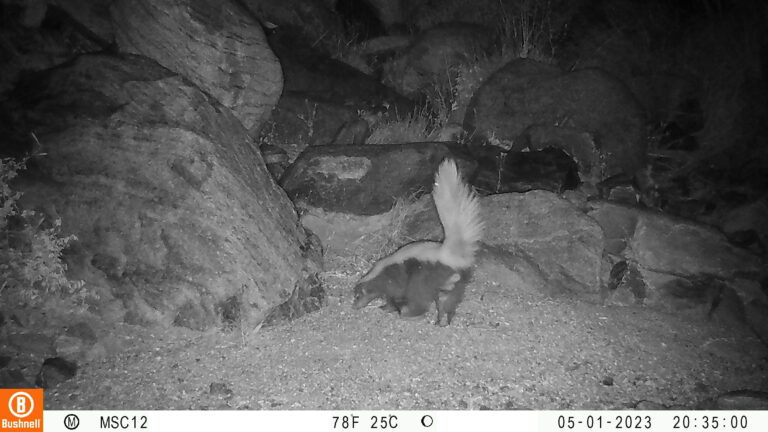Wildlife Camera Project
Why it Matters
Anthropogenic (i.e., human) disturbances, such as urbanization, habitat loss and fragmentation, and climate change, have
resulted in an unprecedented loss of biodiversity, globally.1,2 One of the key species groups to monitor is ground-dwelling
vertebrates (i.e., birds, reptiles, and mammals). These species play key ecological roles and interact with each other and the
environment, where the loss of a particular organism can alter the functioning of the ecosystem.3
McDowell Sonoran Preserve (Preserve) provides important habitat for a diversity of species and is a key habitat corridor
between several protected areas, linking Tonto National Forest to McDowell Mountain Regional Park and the Fountain Hills
Preserve, for a total of nearly 3 million acres of protected lands. This large, contiguous landscape enables more than 1,000
species of plants and animals to thrive in the Preserve. Maintaining protected and connected habitat is an essential part of
conserving ground-dwelling vertebrate populations.
The Conservancy's Work
The Conservancy and its partners have conducted several short-term studies on ground-dwelling vertebrates in the Preserve, such as mule deer and rodents. A long-term monitoring study would help us better understand what factors influence species occurrence and distribution within the Preserve. In addition, understanding wildlife movements in relation to anthropogenic features will enable us to identify and maintain essential habitat linkages. One of the ways to monitor ground-dwelling vertebrates is through wildlife cameras. Wildlife cameras are triggered by heat and motion, taking a photo of the animal as it passes in front of the camera. Therefore, this survey method is an ideal for passively monitoring wild animals without handling them or influencing their behavior.
In 2022, the Conservancy started building our largest wildlife monitoring project, yet! Using the global TEAM protocol4, we surveyed over 80 locations and selected 60 independent locations in the Preserve to place a wildlife camera. Cameras were placed along animal travel ways, such as washes, game trails, and old roads and angled to capture animals moving close to
the ground. For this project, we intend to survey ground-dwelling vertebrates annually at all 60 locations for roughly 40 days in the fall and spring seasons. Once we collect photos from the cameras, they will be uploaded in a software and reviewed by
stewards trained to identify species through photos. This is a long-term wildlife monitoring project that will be active for 5-10
years, or more.
What's Been Found
This project is just beginning, but we already have made some fascinating discoveries. For the first time ever, the Conservancy documented an American hog-nosed skunk (Conepatus leuconotus)! That brings the total number of mammals recorded in the Preserve to 41. In fall 2023, we conducted a survey at 30 locations, documenting 19 unique species (16 mammals, 2 birds, and 1 reptile) and identified a few sites with higher diversity that were either near a water source or farther away from urban development. In 2024, we conducted our first spring and fall surveys at all 60 sites!

This work is essential for understanding the distribution of wildlife in the Preserve, identifying the factors that impact wildlife activity and diversity, identifying important habitat linkages, and recommending targeted management actions, with the goal of maintaining biodiversity in the Preserve, and beyond, in perpetuity.
How You Can Help
1. Keep Wildlife Wild!
- Do not handle, harass or remove wild animals from the wild
- Observe wildlife from a distance using binoculars or cameras
- Do not feed wildlife, it is detrimental to their health and wellbeing
- Secure your trash and make sure pet food is not accessible
- Clean up and Leave No Trace
2. Watch out for animals and slow down on busy roads to avoid collisions.
3. Leash your dog when hiking, for the safety of the dog and wild animals.
4. If you are concerned about injured or abandoned wildlife, please contact a wildlife professional to access the situation.
5. Support McDowell Sonoran Conservancy with a donation or volunteer as a Conservancy Steward
McDowell Sonoran Conservancy Staff Contact
Jessie Dwyer | 480-998-7971 ext. 104 |
jessie@mcdowellsonoran.org
15300 North 90th Street, Suite 400, Scottsdale, Arizona, 85260
Partners
Jessie Lewis, Assistant Professor, Arizona State University School of Integrative Sciences and Arts



Literature Cited
1. McKinney, Michael L. "Urbanization as a major cause of biotic homogenization." Biological conservation 127.3 (2006): 247-260
2. Murphy, Grace EP, and Tamara N. Romanuk. "A meta‐analysis of declines in local species richness from human disturbances."
Ecology and evolution 4.1 (2014): 91-103.
3. Brodie, Jedediah F., Sara Williams, and Brittany Garner. "The decline of mammal functional and evolutionary diversity worldwide."
Proceedings of the National Academy of Sciences 118.3 (2021): e1921849118.
4. Network, T. E. A. M., et al. "Terrestrial vertebrate (camera trap) monitoring protocol implementation manual." Tropical Ecology
Assessment and Monitoring Network, Centre for Applied Biodiversity Science, Virginia, USA (2011).




